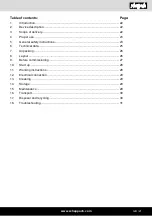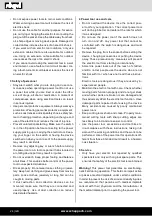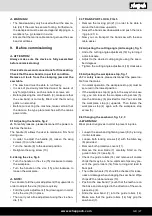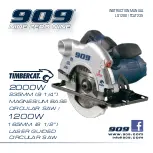
www.scheppach.com
24 | GB
4 Power tool use and care
• Do not overload the device. Use the correct pow-
er tool for your application.
The correct power tool
will do the job better and safer at the rate for which
it was designed.
• Do not use the power tool if the switch does not
turn it on and off.
Any power tool that cannot be
controlled with the switch is dangerous and must
be repaired.
• Remove the plug from the socket before setting the
device, changing accessories or putting the device
away.
These precautionary measures will prevent
the electric tool from starting unintentionally.
• Store idle power tools out of the reach of children
and Do not let people use the device who are not
familiar with it or who have not read these instruc-
tions.
Electric tools are dangerous if they are used by in
-
experienced people.
• Maintain the electric tool with care. Check whether
moving parts function properly and do not get stuck
and whether parts are broken or are damaged and
thus adversely affect the electric tool function.
Have
damaged parts repaired before using the device.
Many accidents are caused by poorly maintained
power tools.
• Keep cutting tools sharp and clean.
Properly main
-
tained cutting tools with sharp cutting edges are
less likely to bind and are easier to control.
• Use the power tool, accessories and tool bits etc.
in accordance with these instructions, taking into
account the working conditions and the work to be
performed. Use of the power tool for operations dif-
ferent from those intended could result in a hazard-
ous situation.
5 Service
•
Only have your electric tool repaired by qualified
specialists and only with original spare parts.
This
ensures that safety of the electric tool is maintained.
Warning!
This power tool generates an electromag-
netic field during operation.
This field can impair active
or passive medical implants under certain conditions.
In order to prevent the risk of serious or deadly injuries,
we recommend that persons with medical implants
consult with their physician and the manufacturer of
the medical implant prior to operating the power tool.
• Do not expose power tools to rain or wet conditions.
Water entering a power tool will increase the risk of
electric shock.
• Do not use the cable for another purpose, for exam-
ple, carrying or hanging the electric tool or pulling the
plug out of the socket.
Keep the cable away from heat,
oil, sharp edges or moving device parts. Damaged or
coiled cables increase the risk of an electric shock.
•
If you work with an electric tool outdoors, only use
extension cables that are also suitable for outdoor
use. Using an extension cable suitable for outdoor
use reduces the risk of an electric shock.
•
If you cannot avoid using the electrical tool in a wet
environment, use a fault-current circuit breaker. Us-
ing a fault-current circuit breaker reduces the risk of
an electric shock.
3 Safety of personnel
•
Stay alert, watch what you are doing and use com
-
mon sense when operating a power tool. Do not use
a power tool while you are tired or under the influ
-
ence of drugs, alcohol or medication. A moment of
carelessness when using electrical tools can result
in serious injuries.
•
Use personal protective equipment. Always wear eye
protection. Wearing personal protective equipment,
such as dust masks, anti-slip safety shoes, safety hel
-
met or hearing protection, depending on the type and
use of the electric tool, reduces the risk of injuries.
• Prevent unintentional starting. Make sure the switch
is in the off-position before connecting to the power
supply, picking up or carrying the electric tool.
Keep-
ing your finger on the switch or having the device
switched on when you connect it to the power supply
may result in accidents.
•
Remove any adjusting key or wrench before turning
the power tool on. A tool or spanner that is located in
a rotating device part may result in injuries.
• Do not overreach. Keep proper footing and balance
at all times. This enables better control of the power
tool in unexpected situations.
•
Dress properly.
Do not wear loose clothing or jewel
-
lery.
Keep hair, clothing and gloves away from moving
parts.
Loose clothes, jewellery or long hair can be
caught in moving parts.
• If dust extraction and collection devices can be
mounted, make sure that they are connected and
used properly.
Use of dust collection can reduce
dust-related hazards.
Summary of Contents for 5901511901
Page 2: ...www scheppach com 2 1 5 1 2 3 4 6 7 8 ...
Page 3: ...www scheppach com 3 2 3 4 9 10 11 12 15a 15 16 17 13 14 ...
Page 4: ...www scheppach com 4 5 18 19 20 21a 21 22 6 23 24 25 22 19 26 24 A B C 15 15a 16 7 ...
Page 243: ...www scheppach com 243 ...
Page 244: ...www scheppach com 244 ...
Page 248: ...www scheppach com 248 ...
Page 252: ...www scheppach com 252 ...
















































